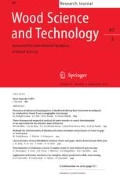Abstract
Scots pine (Pinus sylvestris) sapwood was investigated for variation in treatability using the wood modifying agent, furfuryl alcohol (FA) in water. The variation in treatability within trees, between trees and between different stands of Scots pine was studied. Investigated variables that reduced the residual variance significantly were: site location, latitude of site, height of trees, annual ring width, vertical and horizontal position in the tree and method of drying. Linear mixed model statistics were used and tree number was handled as a random variable. The best model reduced the treatability residual variance by 67%. Location was the single factor affecting treatability most. Differences in latitude between locations may be the reason for that. Latitude correlated negatively with the treatability. Within the trees, the treatability of sapwood increased with distance from ground and with distance from heartwood border. A small, but significantly better treatability was found for kiln dried wood (60°C) compared to air dried wood (20°C).

Similar content being viewed by others
References
Bamber RK, Burley J (1983) The wood properties of Radiata pine. Commonwealth Agricultural Bureaus, Slough, England
Banks WB (1972) Factors affecting the introduction of preservatives into wood. Pesticide Sci 3:219–227
Booker RE (1990) Changes in transverse wood permeability during the drying of Dacrydium cupressinum and Pinus radiata. NZ J For Sci 20:231–244
Booker RE, Evans JM (1994) The effect of drying schedule in the radial permeability of Pinus radiata D. Don Holz Roh Werkst 52:150–156
Comstock GL (1965) Longitudinal permeability of green eastern hemlock. For Prod J 15(10):441–449
Comstock GL (1968) Relationship between permeability of green and dry eastern hemlock. For Prod J 18(8):20–23
Comstock GL, Côté WA (1968) Factors affecting permeability and pit aspiration in coniferous sapwood. Wood Sci Technol 2(4):279–291
Duchesne I, Wilhelmsson L, Spångberg K (1997) Effect of in-forest sorting of Norway spruce (Picea abies) and Scots pine (Pinus sylvestris) on wood and fibre properties. Can J For Res 27:790–795
EN 350-2 (1994) Durability of wood and wood-based products. Natural durability of solid wood. Guide to natural durability and treatability of selected wood species of importance in Europe. European Norm
Hannrup B (2004) Functions for estimating bark thickness of pine and spruce by the use of harvesters Working report No 575 pp 34. Skogforsk, Sweden (in Swedish)
Lande S, Westin M, Schneider MH (2008) Development of modified wood products based on furan chemistry. Mol Cryst Liq Cryst 484:367–378
Larnøy E, Lande S, Vestøl G (2008) Variations of furfuryl alcohol and Wolmanit CX-8 treatability of pine sapwood within and between trees. The International Research Group on Wood Protection Document NO IRG/WP/08-40421
Littell RC, Milliken GA, Sroup WW, Wolfinger RD, Schabenberger O (2006) SAS for mixed models, 2nd edn edn. SAS Institute Inc., Cary, NC, USA
Matsumura J, Booker RE, Ridoutt BG, Donalson LA, Mikajiri N, Matsunaga H, Oda K (1999) Impregnation of Radiata pine wood by vacuum treatment II: effect of pre-steaming on wood structure and resin content. J Wood Sci 45:456–462
Milota MR, Tschernitz JL, Verrill SP, Mianowski T (1995) Gas permeability of plantation loblolly pine. Wood Fiber Sci 27(1):23–40
Nordic Wood Preservation Council (1998) Nordic requirements for quality control and marking of pressure treated timber. Part 1: Pine and other permeable softwoods. NWPC Document 3
Phillips EWJ (1933) Movement of the pit membrane in coniferous woods, with special reference to preservative treatment. Forestry J Soc Foresters 7:109–120
Rhatigan R, Freitag C, El-Kasmi S, Morrell JJ (2004) Preservative treatment of Scots pine and Norway spruce. For Prod J 54(10):91–94
Stamm AJ (1964) Wood and cellulose science. The Ronald Press company, New York, USA
Strand L (1967) Taper tables for Scots pine in southern Norway Meddelelse fra det norske skogforskningen Ves. nr 84, 431–482 (in Norwegian)
Wilhelmsson L (2001) Characterisation of wood properties for improved utilisation of Norway spruce and Scots pine. Doctoral thesis, Swedish university of agricultural science, Uppsala, Sweden
Winandy JE, Green F, Deefe D (2001) Treatability problems—relationship between anatomy, chemical composition and treatability. The International Research Group on Wood Preservation Document NO IRG/WP/08-01-40213, 8 pp
Zobel BJ, Van Buijtienen JP (1989) Wood variation—its causes and control. Springer-Verlag, Berlin Heidelberg, Germany
Acknowledgments
We thank The Research Council of Norway and Kebony ASA for funding the study and the good work by student Georg Behr for preparation and measurement of samples.
Author information
Authors and Affiliations
Corresponding author
Rights and permissions
About this article
Cite this article
Lande, S., Høibø, O. & Larnøy, E. Variation in treatability of Scots pine (Pinus sylvestris) by the chemical modification agent furfuryl alcohol dissolved in water. Wood Sci Technol 44, 105–118 (2010). https://doi.org/10.1007/s00226-009-0272-3
Received:
Published:
Issue Date:
DOI: https://doi.org/10.1007/s00226-009-0272-3




